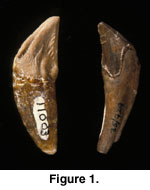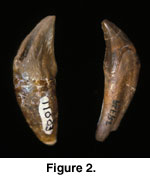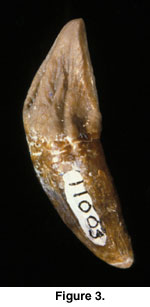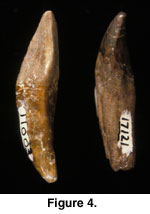CANINES AND SIVAPITHECUS
TAXONOMY AND PALEOBIOLOGY
The Siwalik canines were central to Greenfield’s
(1979) arguments for the synonymy of Ramapithecus and Sivapithecus. Following
Gregory et al. (1938), Greenfield
recognized the morphology of the small GSI D. 299/300 canines as female, but he
also regarded all of the atypical canines to be those of males. Size differences
among these presumed male canines were critical to his demonstration that there
were three species of Sivapithecus that differed only in body size and
male relative canine size. Moreover, Greenfield failed to recognize the
morphological differences between the atypical canines and the more typical
Sivapithecus canines. Thus, one of his Sivapithecus species had
canines of both types included in its hypodigm. Greenfield did, however, make
one critical observation, which he did not pursue further and which was ignored
by later workers, including me initially. That observation was the complete lack
of a distal “posterior attrition” facet on any of the three atypical canines
that he had at his disposal (YPM 13809, GSI D. 192, and GSI D. 308), canines
that had clearly been in occlusion as shown by anterior wear facets. Regarding this curious feature,
Greenfield (1979) stated,
“Whether or not this is an important trend bearing on functional or phylogenetic
questions cannot be ascertained until detailed comparisons with extant pongines
are made.” (p. 534); these comparisons were apparently never carried out.
In a taxonomic revision of
Sivapithecus a few years later,
Kay (1982) either did not notice any
morphological variation in the canine sample or chose not to assess it. He
expressed the opinion that the allocation of Siwalik hominoid maxillary canines
“to a particular species (let alone a particular sex) is impossible” (Kay 1982,
p. 150). He included the atypical canines in a metric analysis of
Sivapithecus canines, from which he concluded that canine sexual dimorphism
in all species of Sivapithecus was quite low.
 My work on hominoid canines
began in early 1981. Although I had access to the Siwalik collections housed at
Yale University and had read
Greenfield’s 1979 paper, my earliest notes on Siwalik canines – dating from a visit to the Geological Survey of India in
February, 1981 – indicate no prior awareness of the details of Siwalik hominoid
canine morphology and wear, nor any recollection of the specifics of
Greenfield’s comments on the Siwalik canines. In my examination of the GSI
material, I noted both the presence of two distinct upper canine morphologies in
the Siwalik sample, one including GSI D. 196, D. 238 and 18066 and the other D.
192, D. 307 and D. 308, as well as the oddly curious feature of the lack of a
distal wear facet among the specimens of the latter group. My characterizations
of the two upper canine morphologies in my notes were as follows (see
Figure 1
and Figure 2):
My work on hominoid canines
began in early 1981. Although I had access to the Siwalik collections housed at
Yale University and had read
Greenfield’s 1979 paper, my earliest notes on Siwalik canines – dating from a visit to the Geological Survey of India in
February, 1981 – indicate no prior awareness of the details of Siwalik hominoid
canine morphology and wear, nor any recollection of the specifics of
Greenfield’s comments on the Siwalik canines. In my examination of the GSI
material, I noted both the presence of two distinct upper canine morphologies in
the Siwalik sample, one including GSI D. 196, D. 238 and 18066 and the other D.
192, D. 307 and D. 308, as well as the oddly curious feature of the lack of a
distal wear facet among the specimens of the latter group. My characterizations
of the two upper canine morphologies in my notes were as follows (see
Figure 1
and Figure 2):
(GSI D. 196, D. 238, 18066)
Highly crenulated enamel, especially disto-lingually, lingual surface strongly
concave mesiodistally, deep mesio-lingual groove with slight to moderate
development of a mesial wear facet and early development of a distal wear facet
along the entire crown length, a more or less straight cemento-enamel junction
[cej] lingually, a robust crown relative to crown height, especially in
bucco-lingual breadth, and a circular/ovoid root at the cej with the root
remaining robust toward its apex;
 (GSI D. 192, D. 307, D. 308)
Smooth enamel, lingual surface strongly convex mesiodistally, a shallow mesial
groove with a marked wear facet, no distal wear facet, a sigmoid shaped cej
lingually, a relatively gracile crown compared to crown height, and a more or
less triangular root at the cej with the root tapering strongly toward the apex.
(GSI D. 192, D. 307, D. 308)
Smooth enamel, lingual surface strongly convex mesiodistally, a shallow mesial
groove with a marked wear facet, no distal wear facet, a sigmoid shaped cej
lingually, a relatively gracile crown compared to crown height, and a more or
less triangular root at the cej with the root tapering strongly toward the apex.
By the time of the publication
by
Raza et al. in 1983 describing two more atypical canines, I had also adopted
the viewpoint expressed by them that the two canine morphologies segregated
temporally, with the atypical canines being restricted to the earlier Chinji
Formation localities, while the more typical Sivapithecus canines came
from younger localities, mostly of the Dhok Pathan Formation. I was strongly
influenced in this assessment by the fact that all the canines for which
provenance was certain, that is, all those collected after the early part of the
century and particularly the many canines recovered by the Harvard-Geological
Survey of Pakistan Project headed by David Pilbeam, segregated in this fashion.
I therefore assumed that the reported provenance of GSI D. 238 (a typical
canine) as being from the Chinji Formation was probably an error, as its
collector, Mr. Vinayak Rao, had also collected from younger sediments at
Haritalyangar (Pilgrim 1915;
Wadia and Aiyengar 1938), and as this specimen had
not in fact been described by Pilgrim. There was also the apparently more
typical hominoid canine fragment (GSI K56/680) from the Chinji-equivalent
sediments at Ramnagar, which I had not seen and the morphology of which I could
not confidently ascertain from the photograph published by
Dutta et al. (1976).
Finally, a broken canine housed at the Natural History Museum, London (BMNH
M34438) has a typical Sivapithecus morphology and was catalogued as being
from Chinji, but it was also collected early in the century. Given the
uncertainties concerning these canines, it was easy for me to rationalize away
any evidence that might have contradicted the notion of temporal segregation of
the two canine morphologies, which later became an instructive lesson in
self-deception.
In my Ph.D. dissertation, I made
features of the Sivapithecus canines the diagnostic characters in a
taxonomic revision that recognized a temporal segregation between what were
regarded as the two most common species, S. sivalensis and S. indicus
(Kelley 1986). This scheme was alluded to but not formally proposed by
Kelley and Pilbeam (1986). By the early 1980s, Sivapithecus taxonomy had
come to be based largely or entirely on size, regardless of the number of
species recognized or their nomenclature (Simons and Pilbeam 1965;
Pilbeam et
al. 1977; Greenfield 1979;
Kay 1982;
Kay and Simons 1983;
Martin 1983). However,
it had become clear to me that sized-based taxa in many instances simply
separated males from females of the same species (Kelley 1986).
 The proposal of
time-successive species therefore took shape in the context of a more
comprehensive effort to revise Sivapithecus taxonomy to unite male and
female individuals of the same species. Since the upper canines were the only
teeth in the Sivapithecus sample that showed clear, discrete variation,
and since this variation seemed to segregate temporally, large and small
specimens from the younger Dhok Pathan Formation were placed in one species,
while those from the older Chinji Formation were placed in another. As noted
above, a specimen of the more typical hominoid canine morphology occurs in the
type specimen of S. sivalensis, which is from the Dhok Pathan Formation,
so this name was applied to the younger species. None of the described
atypical canines is associated with other dental or gnathic remains (one
maxillary specimen from the Chinji Formation preserves an embedded canine root,
which
Raza et al. (1983) incorrectly claimed has a triangular outline
characteristic of the atypical canines), but since the name S. indicus
has priority among type specimens from the Chinji Formation, this name was
applied to the older species (Kelley 1986).
The proposal of
time-successive species therefore took shape in the context of a more
comprehensive effort to revise Sivapithecus taxonomy to unite male and
female individuals of the same species. Since the upper canines were the only
teeth in the Sivapithecus sample that showed clear, discrete variation,
and since this variation seemed to segregate temporally, large and small
specimens from the younger Dhok Pathan Formation were placed in one species,
while those from the older Chinji Formation were placed in another. As noted
above, a specimen of the more typical hominoid canine morphology occurs in the
type specimen of S. sivalensis, which is from the Dhok Pathan Formation,
so this name was applied to the younger species. None of the described
atypical canines is associated with other dental or gnathic remains (one
maxillary specimen from the Chinji Formation preserves an embedded canine root,
which
Raza et al. (1983) incorrectly claimed has a triangular outline
characteristic of the atypical canines), but since the name S. indicus
has priority among type specimens from the Chinji Formation, this name was
applied to the older species (Kelley 1986).
 A few years later, I began a
study of anthropoid canine morphology in an attempt to discern if there were
features by which male and female canines could be reliably distinguished
(Kelley 1995a, 1995b). During this study, I incidentally observed that, because
the distal margin of the upper canine occludes with the mesial face of the lower
anterior premolar (either P2 or P3) in all anthropoids, a
distal wear facet invariably begins to develop on the upper canine as soon as
occlusion is achieved with the lower premolar (Figure 3). None of the
atypical canines that I had seen (eight, including one more recent find of the
Harvard-GSP Project, GSP 23124) had a distal wear facet, although all bore a
large mesial wear facet demonstrating that they had been in occlusion (Figure
4). This confirmed Greenfield’s (1979) observation based on three of these
canines, an observation that had passed unnoticed by virtually everyone else. At
this time I became convinced that these canines could not possibly be hominoid
canines, but I had no idea as to which animal they did belong.
A few years later, I began a
study of anthropoid canine morphology in an attempt to discern if there were
features by which male and female canines could be reliably distinguished
(Kelley 1995a, 1995b). During this study, I incidentally observed that, because
the distal margin of the upper canine occludes with the mesial face of the lower
anterior premolar (either P2 or P3) in all anthropoids, a
distal wear facet invariably begins to develop on the upper canine as soon as
occlusion is achieved with the lower premolar (Figure 3). None of the
atypical canines that I had seen (eight, including one more recent find of the
Harvard-GSP Project, GSP 23124) had a distal wear facet, although all bore a
large mesial wear facet demonstrating that they had been in occlusion (Figure
4). This confirmed Greenfield’s (1979) observation based on three of these
canines, an observation that had passed unnoticed by virtually everyone else. At
this time I became convinced that these canines could not possibly be hominoid
canines, but I had no idea as to which animal they did belong.

 My work on hominoid canines
began in early 1981. Although I had access to the Siwalik collections housed at
Yale University and had read
Greenfield’s 1979 paper, my earliest notes on Siwalik canines – dating from a visit to the Geological Survey of India in
February, 1981 – indicate no prior awareness of the details of Siwalik hominoid
canine morphology and wear, nor any recollection of the specifics of
Greenfield’s comments on the Siwalik canines. In my examination of the GSI
material, I noted both the presence of two distinct upper canine morphologies in
the Siwalik sample, one including GSI D. 196, D. 238 and 18066 and the other D.
192, D. 307 and D. 308, as well as the oddly curious feature of the lack of a
distal wear facet among the specimens of the latter group. My characterizations
of the two upper canine morphologies in my notes were as follows (see
Figure 1
and Figure 2):
My work on hominoid canines
began in early 1981. Although I had access to the Siwalik collections housed at
Yale University and had read
Greenfield’s 1979 paper, my earliest notes on Siwalik canines – dating from a visit to the Geological Survey of India in
February, 1981 – indicate no prior awareness of the details of Siwalik hominoid
canine morphology and wear, nor any recollection of the specifics of
Greenfield’s comments on the Siwalik canines. In my examination of the GSI
material, I noted both the presence of two distinct upper canine morphologies in
the Siwalik sample, one including GSI D. 196, D. 238 and 18066 and the other D.
192, D. 307 and D. 308, as well as the oddly curious feature of the lack of a
distal wear facet among the specimens of the latter group. My characterizations
of the two upper canine morphologies in my notes were as follows (see
Figure 1
and Figure 2):

